Podcast: Play in new window | Download (Duration: 27:22 — 32.5MB)
Subscribe: Apple Podcasts | Spotify | Amazon Music | Android | Pandora | iHeartRadio | JioSaavn | Podcast Index | Email | TuneIn | RSS | More
By Davy Crockett
You can read, listen, or watch




| Get Davy Crockett’s new book, Frank Hart: The First Black Ultrarunning Star. In 1879, Hart broke the ultrarunning color barrier and then broke the world six-day record with 565 miles, fighting racism with his feet and his fists. |
Early Running
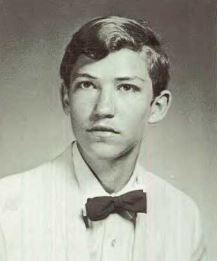
The Brannen family were Irish Catholics from Upper Darby, a suburb of Philadelphia, Pennsylvania. He went to Catholic schools growing up, including St. Joseph’s Prep in Philadelphia. In high school, he was required to participate in an athletic extracurricular activity. Dan explained, “I was a shrimpy little kid. I played little league baseball, but I wasn’t particularly athletic or coordinated. One of the sophomores who came in to give the orientation, said, ‘If you can’t do anything else, go out for cross-country.’ So, I did, my freshman year even though I was terrible at it.”
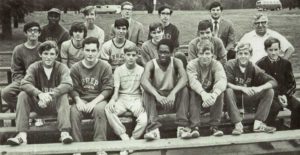

During Dan’s senior year, a new coach, Larry Simmons (1942-2004), a successful distance runner and racewalker took over the team. He lit a fire into the team and into Dan whose course times dramatically improved, resulting in his promotion to the varsity team. His rapid success, instilled by the inspiration of Simmons, turned him into a runner for life.
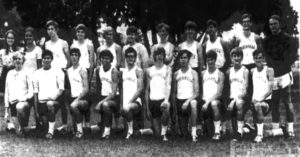

Dan went to Bucknell University in Central Pennsylvania and got in on the ground floor of a new cross-country team. His coach, Art Gulden (1942-2001) developed the team into a highly successful running program at Bucknell. Dan continued to improve under his tutelage and recalled, “Each year Gulden was able to recruit faster and faster high school runners. They included state champions, and it was very competitive. I was able to stay with the second tier of those guys. One of the best feelings I had about myself as an improving runner was when I was running and keeping up with state high school champions.”
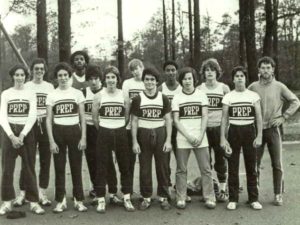

Dan ran a few marathons during college, graduated in 1975, and joined the well-established road-racing scene in the Philadelphia and New Jersey area. He was a self-described “running bum,” living a subsistence lifestyle as he concentrated on his running passion. His weekly mileage would average about 100-120 miles per week.
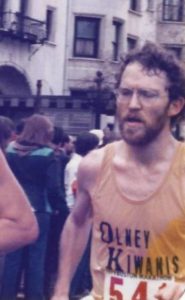

His personal best marathon occurred at the 1979 Boston Marathon which he ran in 2:31:13. He was intoxicated with distance running and it would later evolve into a true career for life. Part-time he worked editing research manuscripts which enhanced his writing skills. He also coached cross country at his former high school for a few of these years in the late 1970s.
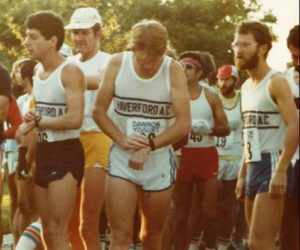

Dan ventured into the shorter ultrarunning races in 1978, running the Knickerbocker 60 km in Central Park, and ran in a few others the next year, including the classic ultra, Two Bridges 36-mile Road Race in Scotland.
Win at 1980 JFK 50
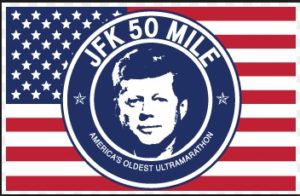

Dan went to JFK thinking that he might have a good chance to win. His specialty was gnarly, rocky, technical trails. He knew that he could stay with people who were faster than him on roads and hoped to keep up with the previous year’s champion, Bill Lawder (1947-) of New Jersey.
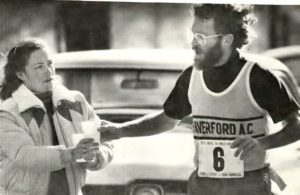

Dan’s JFK 50 start did not go smoothly. He explained, “I was probably the only person ever to win the JFK to start in absolute dead last and end up in first. When the gun went off, I was in the porta-potty with my sweats still on. I heard the gun, rapidly finished my business, and almost tripped over my sweats as I tried to get them off and run at the same time. When I got to the start line, I could barely see the final stragglers. I ran through most of the field for those first three road miles and mowed my way through the field until I caught and passed Bill Lawder with three miles to go on the Appalachian Trail.”
Dan continued, running an ideal race. Two others ahead of him soon dropped out and he went into the lead at about mile 20. He was later passed by Lawder on the C&O Towpath but caught him on the final long road uphill toward the finish and won by nine minutes with 6:14:02.
Racing and Directing Ultras
During the next few years, Dan branched out and started organizing and race-directed classic early ultras including the Great Philadelphia to Atlantic City race and the Haverford indoor 24-hour and 48-hour races. His first 100-miler was at Fort Meade, Maryland on a track in 1981, where he finished in third place with 17:45:56. In later years he would run trail 100-milers at Western States, Old Dominion, Massanutten, and Wasatch Front.
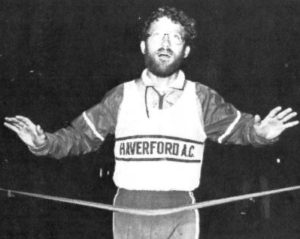

In 1982, Dan organized, ran, and won perhaps the earliest modern-day 200-mile race, the “Johnny Salo Road Race” across New Jersey from High Point, New Jersey, to Cape May. The race with 15 starters was named after Johnny Salo, perhaps the greatest American ultrarunner during the 1920s, who won the 1929 race across America, nicknamed “The Bunion Derby.” He was New Jersey’s hero. Dan managed to track down Salo’s daughter, Helen Salo Lotz, who brought family and some of her father’s memorabilia for a pre-race dinner.


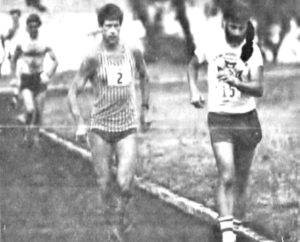

At the Weston Six-day later held that year in New Jersey, he met Englishman Malcolm Campbell. Campbell expedited Dan’s entrance in the 1983 international La Rochelle 6 day in France. Dan finished 5th, running 468 miles to rank as #2 American for the year. Dan said, “It had an international feel to it. It was a spectacular environment. It was indoors, there were people in the stands surrounding the track 24 hours a day. They had a restaurant and band playing in the middle of the oval.”
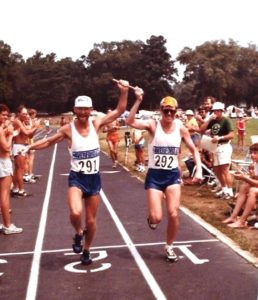

In 1983, along with Neil Weygandt, they attempted to break the world two-man 24-hour relay record of 193 miles. They made their attempt on a track at Mullins Field in Fort Meade, Maryland, and successfully surpassed the mark with 199.5 miles, averaging 7:16-minute miles between them—only to later discover that two men in South Africa had run 201 miles the same weekend.
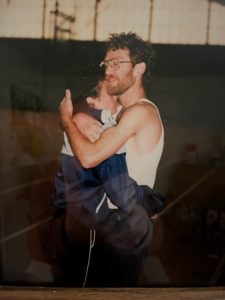

In 1985 Dan ran 223.2 miles indoors at Haverford 48 hours to break Ray Krolewicz’s 48-Hour American Record by a mile, only to lose it back to Krolewicz within a year.
Co-founding the International Association of Ultrarunners (IAU)
Dan’s greatest contributions to the sport of ultrarunning came when he worked tirelessly to organize the sport worldwide during the late 1980s. Gary Cantrell (Lazarus Lake) wrote at that time, “Thanks, in large part to Dan’s efforts, our sport appears well on the way from being a mere diversion among running’s fringe element to establishing a place among respected amateur sports. Dan was aware of the effects when a governing body is unconcerned about and unresponsive to, the needs of a large group of constituents.”
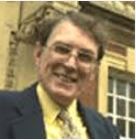

In the early 1980s, Dan had mail contact with Andy Milroy of England who had been involved in the collection and ranking of international ultra statistics for several years, working with Antonin Heyda and Nick Marshall of Pennsylvania. Dan recalled, “It became immediately obvious to me the incredible value of Milroy. He was like a thorough-going archivist and statistician, and he was in touch with other like-minded folks. In our communications, everybody was getting some information about ultramarathons held in the United States, Great Britain, and South Africa. Those were the three countries we knew about, but it turned out that Milroy was getting information of events and movements in places like Japan, France, Bolivia, and even behind the Iron Curtain.”
The excitement and thrill of these communications inspired the idea in Dan that ultrarunning could be organized on a global scale. He proposed the notion of an international ultrarunning association through correspondence to Milroy, Edgar Patterman of Austria, and Malcolm Campbell of England.
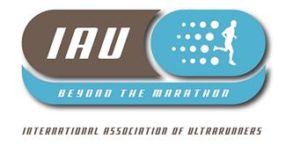

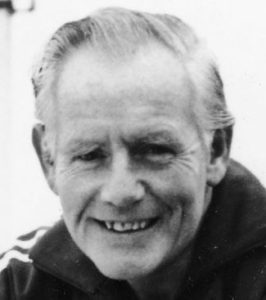

Malcolm Campbell was chosen as the first IAU president, Andy Milroy as statistician, and Dan Brannen as general secretary. Dan would hold that position for about 15 years. Campbell had the charisma necessary to charm others and ease politics with other organizations.
In the June 1984 issue of Ultrarunning Magazine, Dan announced the formation of the IAU. “The preliminary goals of the association are: To foster communication and cooperation between ultrarunners of all countries, regardless of ethnic or national considerations, and to establish international guidelines for the conduct of events and for accurately measuring standard-distance courses.” In addition, they had goals to maintain ultrarunning records in some form.
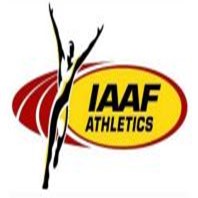

They started to work on an IAU charter, an international calendar of bona fide events, standardized lap-recording procedures, and guidelines for conducting ultramarathons on all surfaces, including trails.
Working to Legitimize the IAU
Skeptics of the new organization voiced their opinions. Fears were expressed that the IAU would be a governing body forcing runners to comply with stringent amateur eligibility requirements and qualification standards to complete in ultras. Dan quickly diffused these fears as being unfounded.
Throughout 1985, Dan and the other IAU executives worked to define their mission, making it clear that its activities would involve international communication and cooperation, and not in competition with any governing athletics or running organizations that governed the sport. Among their first goals was to develop an International 100 km and 24-hour world championship series.
World “Championships”
In June 1986 several U.S. men ultrarunners competed as an informal team in an international 100 km race that was not organized by the IAU. It was the Torhout 100 km in Belgium. There was some controversy about how the U.S. team members were selected for that race and received free airfare to compete. At that time there, of course, was no Internet, and poor grapevine communications were used to learn about international events and who were the right runners to be invited and some felt unfairly excluded.
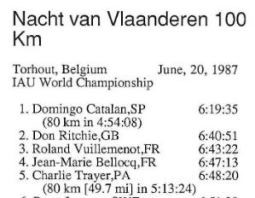

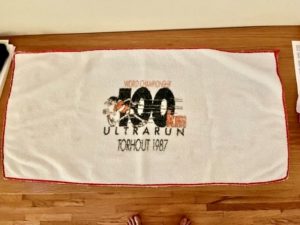

After the 1987 inaugural World Championship, the IAAF flexed its muscles and would not approve of letting the IAU call these events “championships.” Treading softly, beginning in 1988, the IAU then referred to these competitions as “World Challenges Under the Patronage of the IAAF.” It would take the IAAF more than another decade to fully embrace the IAU and allow any ultramarathon to carry the designation “World Championship.”
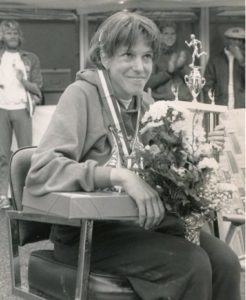

In 1988, the World 100km was held in northern Spain, the Santander 100 km. The IAAF was involved in a supervisory capacity and the race saw a wider number of elite runners from multiple continents and more than a dozen nations, along with the beginning of the participation of national teams. Ann Trason won with a world record of 7:30:49. Word was spread at European races about the IAU and the good work that was taking place.
The major long-lasting benefit of Dan’s work with the IAU was to establish the world championships, bringing together an international community of ultrarunners. A secondary benefit was that, due to the cooperative and mutually respectful relationship established between IAU and the IAAF from the outset, other national federations (in Europe, Oceania, Africa, South America, and Asia) which were disinterested in ultrarunning (sometimes dismissively and aggressively so) eventually allowed their ultrarunners and ultra events into their official framework, due to the powerful authority wielded by the IAAF over every national running federation in the world.
Gaining American Ultrarunning Acceptance
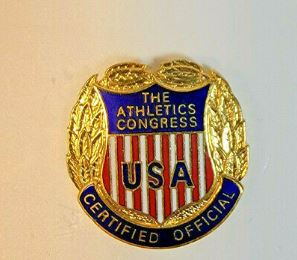

For American ultrarunning, official national championship record designation was limited to the 50K and 50-mile distances for men and women, and the 100-mile distance for men only.
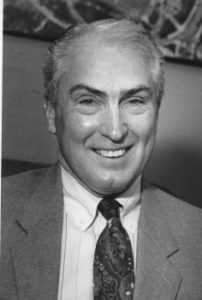

In 1986, Ollan Cassell, a gold medal winner at the 1964 Olympics (4×400 meter relay), was the executive director of TAC. He had firm “iron hand” control over TAC at the time. Dan boldly approached him, expressing the wish to bring ultrarunning formally into the TAC federation. Cassell firmly denied the request, feeling that ultrarunning was too much of an outlier compared to the rest of the running sport. The president of TAC, Frank Greenberg, of Philadelphia, with whom Dan had been friendly from the Philadelphia road running community, encouraged him to not give up and go ahead and present the idea to the long-distance committee. They were very supportive, and he then presented to the entire TAC executive committee, where they voted in favor, despite Cassel’s objections. Once that decision was made by the executive committee it was just a matter of time until full TAC recognition was achieved for ultrarunning.
In December 1986, thanks to Dan’s work, a TAC Ultra Subcommittee was formed with Dan as the chairman. He served in that capacity for nine years.
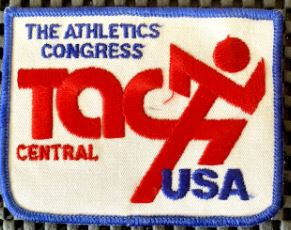

Dan worked to help ultrarunning fit in and be accepted by the rest of the running world. Not all ultrarunners wanted their sport to identify with any formal organizations like TAC. This was especially true for many trail ultrarunners, who only wanted a free-wheeling, no-rules sport that had more to do with “adventure, risk, exploration, and discovery.” But Dan had the foresight to see the benefits of organization and communication, especially if records wanted to be recognized. He had to wade through the bureaucracy of TAC that included “turf wars, power-mongering, and politicking.”
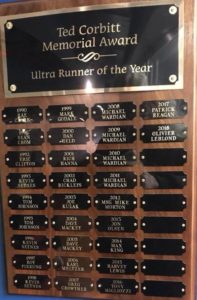

Within a few years, Dan had virtually singlehandedly worked through the not always accepting or cooperative political labyrinth of TAC to achieve status for US national ultra teams and National Championships. Think of it this way, Dan attended all the boring meetings, and had all the fights with bureaucracy, to make it possible for ultrarunners to run, experience national teams, international races, and receive treasured awards.
Controversies
As with any effort trying to make high-impact changes in administration, the environment was highly political, and Dan was not shy about ruffling feathers and had many critics. Publicly, he stepped into the great debates conducted in Ultrarunning Magazine including if pacing should be allowed on trails if formal organizations helped or hurt ultrarunning if Badwater to Mt. Whitney FKT should be limited to the summer and the hotly debated South Africa boycott controversy.
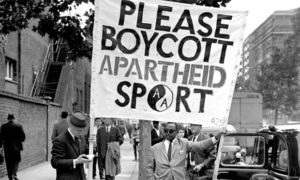

In 1988, controversy arose as the IAAF had a global boycott in place of all running competitions in South Africa because of the continuing racial apartheid policies. They also banned any runners from South Africa from competing in their races in other countries until apartheid ended. Dan and the IAU tried to warn the ultrarunning community.
Further controversy arose in February 1989, when some world elite ultrarunners (from Europe and North America) participated in the international “Standard Bank 100 km” race organized in Stellenbosch, South Africa and the runners faced suspension by the IAAF and TAC. If suspended runners participated in another ultra, anywhere, race directors and potentially runners that participate in the ultra could also be suspended. Dan and the IAU had to wade into the issue with the IAAF and advocated leniency for temporary suspensions, but Dan made it clear that he personally had “no qualms about a ban against participation in athletic events that showcase a racist system of government.”
Dan received some heat from critics as he continued in his efforts to unify ultrarunning. Gary Cantrell defended his efforts in 1989. “Dan has strong opinions just like the rest of us. But as a leader, spokesman, and organizer, it is mandatory that representing the majority opinion and working for the long-term welfare of the sport take precedence over personal feelings. As a result, Dan has spent much of his time stuck in the middle between the stiff-necked administrators of amateur athletics and the bandits and renegades that populate the ultrarunning community. Fortunately for us, Dan has played the political game with the same intelligence and dogged determination that marked his running career. His perseverance has brought our sport to a level few would have predicted and through it all, Dan has retained his clear vision of what needs to be achieved.”
Ultra World Championships Began to be Held
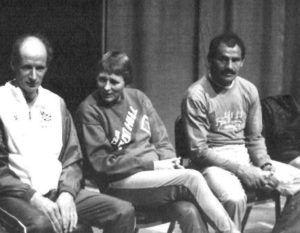

In 1990, Dan’s efforts to have TAC officially recognize U.S. national ultra teams were approved. The inaugural IAU 24-Hour International Championship was held at Milton Keynes, England, complete with team uniforms. Dan was also instrumental in getting TAC, IAU, and IAAF approval for the 1990 100 km World Championship to be held at Edmund Fitzgerald 100 km in Minnesota. Dan and Bill Wenmark, the race director, worked tirelessly on the race.
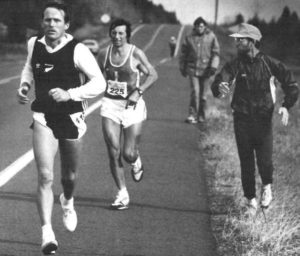

The World Championship turned out to be amazing. “All the foreigners loved it. Andy Milroy said that the historic significance of that event was, that the first three places were taken by runners from three different continents and two different hemispheres.”
Apartheid ended, suspensions were lifted, the Berlin Wall came down, Germany was reunited (resulting in one of the most accomplished national ultra teams), and international ultra championships started to flourish worldwide, with much thanks to Dan. He had direct hands-on involvement in twenty-one U.S. National Ultra Championships, twelve 100 kms, and nine 24-hours. In addition, he was the manager/coordinator for U.S. Teams at nine World 100 km Championships.
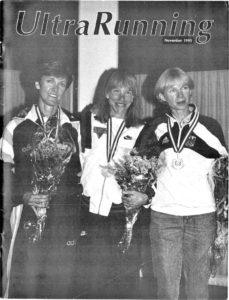



American Ultrarunning Association (AUA)
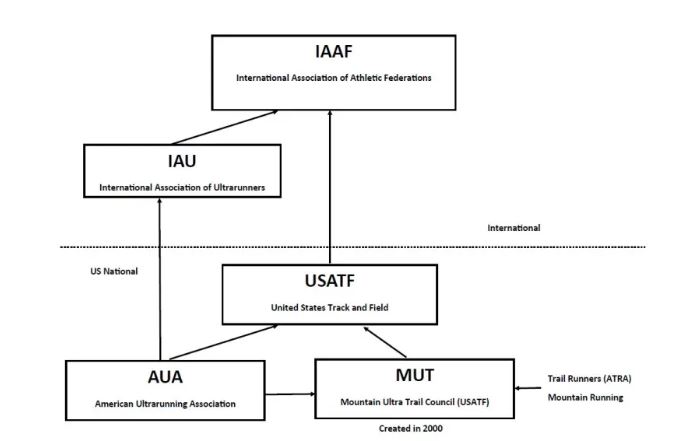

For his dedicated work, Dan was awarded USATF’s Presidents Award in 1992, the highest honor given to volunteers for administrative accomplishments at the national level.
Dan has been a prolific writer for the sport. Over the years he published at least 40 articles in Ultrarunning Magazine including an excellent history of American ultrarunning, co-authored with Andy Milroy, in at least 16 parts in 1998-99.
In 1991, Dan won the Lew Gibb Award which recognizes an individual who has made a significant and dedicated contribution to the sport of running in New Jersey.
American Ultrarunning Hall of Fame
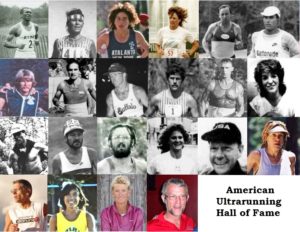

Recent Years
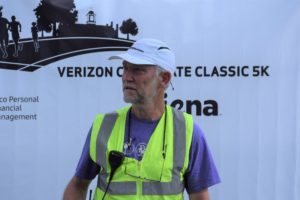

He became one of the very few who successfully made running his career. He did it by establishing a running race timing business (DJB Event Consultants) and for years timed local road races almost every weekend. He also became a course certifier and was the course manager for the 1988 US Olympic Trials Marathon in New Jersey, along with other very prominent races, most notably the Philadelphia Marathon. He has been the official course measurer, and course signage installation manager, of the New York City Marathon for the past two decades.
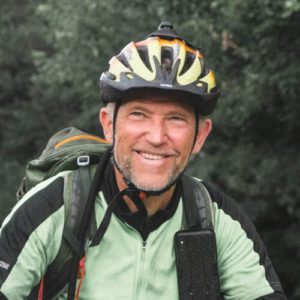

Dan became an expert in logistics and operations for road races, triathlons, and cycling races. He served for ten years as the course director for the NJ Gran Fondo cycling event, which was voted by Gran Fondo Guide magazine as the #1 Gran Fondo event in the country 3 years in a row. In 2022 Dan continues to run, put on local races, and his passion is competing in adventure racing including mountain biking, canoeing, trail running, cross-country skiing, and orienteering.
Dan recently celebrated his 37th wedding anniversary to Joyce Hayes, a runner, and triathlete who was an age-group podium finisher at the Ironman distance Triathlon in Lake Placid, NY. Dan and Joyce ride together in over a half dozen Gran Fondo ultra cycling events each summer.
Dan’s running PRs: half marathon, 1:10:07, marathon, 2:31:13 (Boston 1979), 50K, 3:19, 100k, 7:52, 100 miles, 15:09:40, 24 hours, 135 miles, 48 hours, 223 miles, six days, 468 miles.
Dan Brannen’s Contribution to Ultrarunning
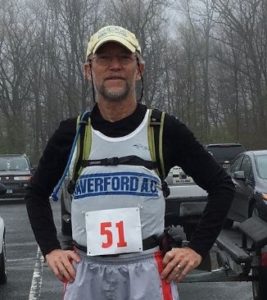

Ultrarunning Hall of Famer, Kevin Setnes added: “While a few people saw the importance of governance by a national governing body, no one possessed the foresight, saw the importance of, or had the political acumen to navigate the bureaucracy of TAC (USATF). Under Dan’s leadership, ultrarunning gained acceptance within the long-distance running body. While still fringe by its nature, the rules of competition, course measurement, and records helped legitimize the sport and gain its acceptance. Today’s recognized national championships and the formation of national teams are largely a credit to Brannen’s persistence.”
